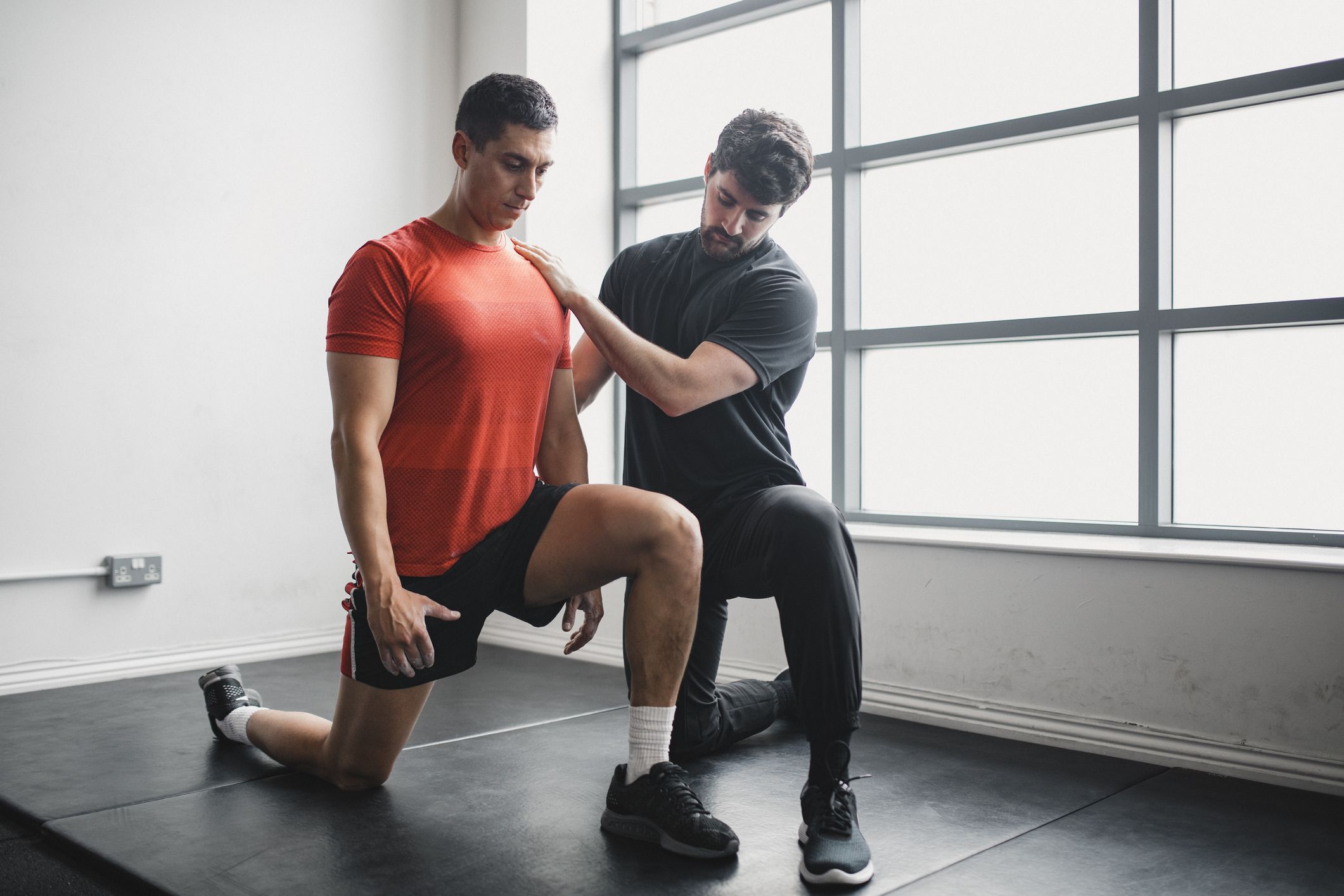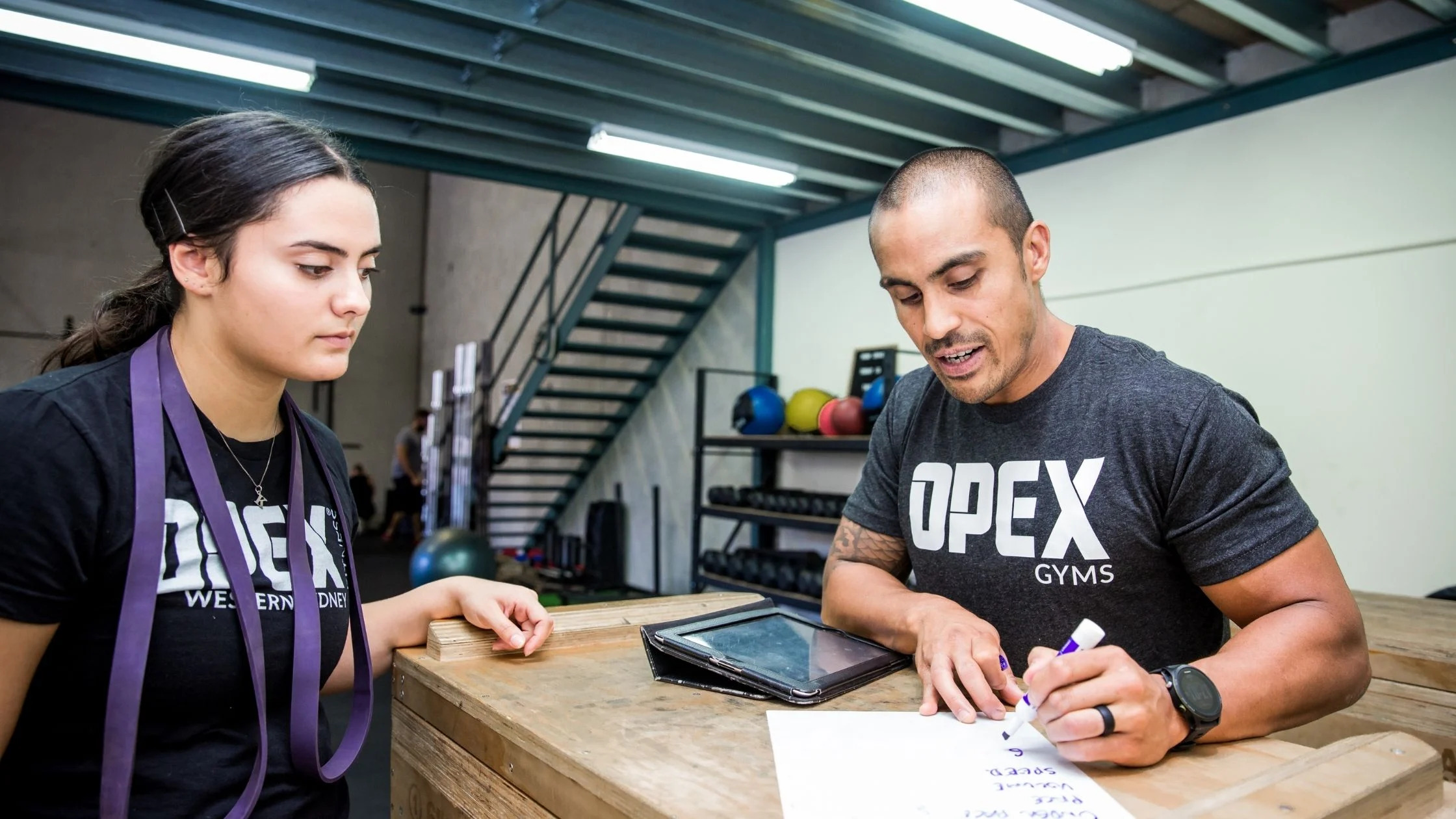Home>Misc>Featured>Which Style Of Personal Training Pairs Two Clients Together During A Workout


Featured
Which Style Of Personal Training Pairs Two Clients Together During A Workout
Modified: January 2, 2024
Discover the benefits of our featured personal training style that pairs two clients together for a dynamic and effective workout. Enhance your fitness journey with the support and motivation of a workout partner.
Introduction
Personal training is an effective way to achieve fitness goals and improve overall health. Traditionally, personal training involves a one-on-one session between a client and a trainer. However, there is a growing trend in the fitness industry that pairs two clients together during a workout session, known as partner training.
Partner training involves two individuals working out together under the guidance of a personal trainer. This style of training offers a range of benefits, including increased motivation, accountability, and the opportunity to build camaraderie with a workout partner. By combining the expertise of a trainer with the support and encouragement of a partner, clients can push themselves further and achieve greater results.
Partner training can take various forms, each with its own unique style and focus. From circuit training to high-intensity interval training (HIIT), there are numerous options available that cater to different fitness levels and objectives. In this article, we will explore the different styles of personal training that pair two clients together, as well as considerations for pairing clients based on their fitness goals and compatibility.
Whether you are a fitness enthusiast looking for a fresh approach to your workouts or a personal trainer interested in incorporating partner training into your sessions, this article will provide valuable insights and guidance. So, let’s dive into the world of partner training and discover how it can revolutionize your fitness journey.
Benefits of Partner Training
Partner training offers numerous benefits that can enhance your fitness journey and overall well-being. Here are some key advantages of incorporating partner training into your workouts:
- Motivation and Accountability: Working out with a partner creates a sense of shared motivation and accountability. You are more likely to stay committed to your program when you have someone relying on you to show up and give your best effort. The presence of a partner can push you to work harder and stay consistent with your workouts.
- Increased Fun and Enjoyment: Exercising with a partner can make your workouts more enjoyable and fun. It provides an opportunity for friendly competition, camaraderie, and social interaction, which can make the entire fitness experience more satisfying and engaging. You can celebrate milestones together, share laughs, and make lasting memories while working towards your fitness goals.
- Improved Technique and Form: Having a workout partner allows for real-time feedback and correction of exercise technique and form. They can provide valuable cues and support to ensure you are performing the exercises correctly and safely. This can lead to better results and reduce the risk of injury.
- Pushing Beyond Limits: When you work out alone, it can be easy to settle into a comfort zone and not push yourself to your full potential. With a partner, you can push each other beyond your limits, encouraging one another to go the extra mile and achieve new milestones. The friendly competition and support can help you break through plateaus and reach new heights in your fitness journey.
- Accountability Outside the Gym: Partner training extends beyond just the confines of the gym. Your workout partner can support you outside of training sessions by motivating you to make healthy choices, sticking to your nutrition plan, and staying consistent with your fitness routine. They can be a source of motivation and guidance throughout your fitness journey.
Partner training offers a dynamic and effective approach to achieving your fitness goals. The combination of motivation, accountability, fun, and support makes it an excellent choice for individuals of all fitness levels. Now that we’ve explored the benefits of partner training, let’s delve into the different styles of personal training that pair two clients together.
Different Styles of Personal Training
When it comes to partner training, there are various styles and approaches that personal trainers can incorporate into their sessions. Each style offers a unique focus and intensity level, allowing trainers to tailor workouts to their clients’ specific goals and preferences. Here are five popular styles of personal training that pair two clients together:
- Circuit Training: Circuit training involves a series of exercises performed in a specific sequence with minimal rest in between. It combines cardiovascular exercises with strength and resistance training to provide a full-body workout. In partner circuit training, clients alternate between exercise stations, working together to complete the set number of repetitions or time. This style of training promotes cardiovascular endurance, muscular strength, and coordination.
- Partner Exercises: Partner exercises involve movements that require two individuals to work together, often relying on one another’s body weight or resistance. Examples include partner squats, push-ups with claps, and assisted stretching. Partner exercises not only challenge your muscles but also enhance coordination, balance, and communication skills.
- High-Intensity Interval Training (HIIT): HIIT is a time-efficient and intense style of training that alternates between short bursts of high-intensity exercises and brief recovery periods. In partner HIIT sessions, clients can take turns performing exercises while the other rests or provides support and encouragement. This style of training is known for its calorie-burning benefits, improved cardiovascular fitness, and increased metabolic rate.
- Strength and Resistance Training: Strength and resistance training involve using weights, resistance bands, or bodyweight exercises to build muscular strength and endurance. In partner strength training, clients can work together by spotting each other or providing resistance during specific exercises. This style of training promotes muscle growth, bone density, and overall functional fitness.
- Functional Training: Functional training focuses on movements that mimic everyday activities and improve overall movement patterns. Partner functional training often involves exercises that require coordination, stability, and balance, such as medicine ball throws, partner lunges, and partner planks. This style of training enhances overall body strength, mobility, and flexibility.
Each style of training offers its own benefits and caters to different fitness goals. Personal trainers can utilize a combination of these styles and tailor them to their clients’ specific needs and preferences. It’s essential to consider factors such as fitness level, goals, and any physical limitations when deciding which style of training to incorporate into partner sessions. Now that we’ve explored the different styles of personal training, let’s move on to the considerations for pairing clients effectively.
Circuit Training
Circuit training is a highly effective style of personal training that pairs two clients together for a dynamic and engaging workout. In circuit training, clients move through a series of exercise stations with minimal rest in between. Each station targets a specific muscle group or fitness component, such as cardiovascular endurance, strength, or flexibility.
Partner circuit training adds an extra layer of motivation and accountability. Clients take turns performing the exercises at each station, allowing for active rest periods and providing encouragement and support to their partner. This teamwork not only enhances the workout experience but also promotes camaraderie and friendly competition.
The benefits of circuit training are numerous. It improves cardiovascular fitness, muscular strength, endurance, and flexibility. The high-intensity nature of circuit training also leads to increased calorie burn and improved metabolic rate. Moreover, the constant variation in exercises keeps the workout engaging and prevents boredom.
To design a circuit training session for partners, a personal trainer may include exercises such as push-ups, squats, lunges, kettlebell swings, planks, and burpees. The trainer can set a specific number of repetitions or time at each station, ensuring that both clients challenge themselves and work towards their individual goals.
It’s important for the trainer to consider the fitness level and abilities of each client when planning the circuit. Exercises can be modified or progressed based on individual needs, allowing each client to work at their own pace and level of intensity. The trainer should also ensure proper form and technique to minimize the risk of injuries.
Partner circuit training is an excellent choice for individuals who enjoy a fast-paced and varied workout. The camaraderie and support between partners create a motivating environment, pushing each client to give their best effort. Whether you’re aiming to improve cardiovascular fitness, build strength, or lose weight, circuit training with a partner can help you achieve your goals in a fun and efficient way.
Partner Exercises
Partner exercises are a fun and interactive aspect of partner training. They involve movements that require two individuals to work together, utilizing each other’s body weight or providing resistance. Partner exercises not only provide a unique and engaging workout experience but also offer a range of benefits for both clients.
One of the key advantages of partner exercises is the increased level of motivation and accountability. When performing exercises with a partner, there is an inherent sense of teamwork and support. You are less likely to skip a workout or give less effort when someone else is relying on you. This added accountability can help you stay on track and push beyond your usual limits.
Partner exercises also improve coordination, balance, and communication skills. Many partner exercises require synchronization and communication between both individuals to execute the movements effectively. This coordination enhances overall body control and spatial awareness, leading to improved athletic performance and reduced risk of injuries.
There is a wide range of partner exercises that can target different muscle groups and fitness goals. Some examples include partner squats, where one partner provides resistance by holding onto the other’s shoulders while performing squats, and partner medicine ball tosses, which engage the core and upper body while promoting hand-eye coordination.
Partner exercises can also be incorporated into traditional exercises such as push-ups, planks, and lunges. For instance, performing push-ups with alternating high-fives at the top engages the chest, shoulders, and triceps while adding an element of fun and interactivity. Partner-assisted stretching is another effective way to improve flexibility and range of motion.
Personal trainers can customize partner exercise routines based on the fitness levels and goals of their clients. Whether the objective is to build strength, improve endurance, or enhance flexibility, there are countless partner exercises to choose from. Trainers should ensure that clients perform the exercises with proper form and technique to maximize effectiveness and reduce the risk of injuries.
Partner exercises not only provide physical benefits but also foster a sense of camaraderie and teamwork. The shared experience of working towards a common goal can strengthen the bond between partners and make the workout more enjoyable. Incorporating partner exercises into training sessions adds variety and excitement, making it a great option for those who prefer a social and interactive workout.
High-Intensity Interval Training (HIIT)
High-Intensity Interval Training (HIIT) is a popular style of training that pairs two clients together for short bursts of intense exercise followed by brief recovery periods. HIIT is known for its effectiveness in burning calories, improving cardiovascular fitness, and boosting metabolism. When performed with a partner, HIIT workouts can be even more challenging and enjoyable.
In partner HIIT sessions, clients alternate between performing exercises while the other rests, provides support, and offers encouragement. This arrangement ensures that both clients receive equal work and recovery time. The presence of a partner can push you to give your best effort, keeping the intensity levels high throughout the workout.
One of the main benefits of HIIT is its time efficiency. HIIT workouts typically last between 20-30 minutes, making them a convenient option for individuals with a busy schedule. This style of training involves short bursts of high-intensity exercises, such as sprints, burpees, and kettlebell swings, followed by brief recovery periods.
Partner HIIT workouts can be designed to target various fitness components, including cardiovascular endurance, strength, and power. The trainer can incorporate exercises that involve partner resistance, such as resistance band sprints or partner medicine ball slams. These exercises not only challenge your muscles but also add an element of coordination and teamwork.
The intensity of HIIT training leads to the afterburn effect, also known as excess post-exercise oxygen consumption (EPOC). This means that even after the workout is over, your body continues to burn calories at an elevated rate for several hours. This can contribute to weight loss and improved metabolic health.
It’s essential to consider individual fitness levels and goals when implementing partner HIIT workouts. The trainer can modify exercises or provide regressions to ensure that each client is working at an appropriate intensity level. Safety should always be a priority, and proper form and technique should be emphasized to prevent injuries.
Partner HIIT training is a fantastic option for those looking to push their limits, challenge themselves, and achieve results in a short amount of time. The combination of intense exercises, active recovery, and the support of a workout partner creates a motivating and exhilarating training environment. So, partner up and experience the power of HIIT for your fitness journey.
Strength and Resistance Training
Strength and resistance training is a vital component of any well-rounded fitness program. When paired with a partner, this style of training takes on a new dimension, allowing for increased intensity, motivation, and support. Partner strength and resistance training provide numerous benefits and can be tailored to meet the specific goals and preferences of each individual.
One of the primary advantages of partner strength training is the ability to provide support and assistance during exercises. For example, during exercises like bench press or squats, a partner can act as a spotter, ensuring safety and providing guidance. This level of support allows you to lift heavier weights and challenge your muscles in a more controlled manner.
Partner strength training also adds an element of friendly competition and motivation. The presence of a partner can push you to work harder and strive for better results. By observing your partner’s progress and effort, you can get inspired and motivated to reach new levels of strength and endurance.
There are various exercises that can be performed with a partner to target different muscle groups and fitness goals. These include partner-assisted pull-ups, where one partner provides assistance or resistance during the movement, and partner medicine ball passes for core and upper body strength. Additionally, partner resistance band exercises, such as lateral band walks or bicep curls, add a dynamic element to strength training sessions.
The customization and progression of partner strength training exercises are crucial. Personal trainers should consider the individual fitness levels and goals of each client, ensuring that exercises are appropriate and challenging. Proper form and technique should be emphasized to optimize results and reduce the risk of injury.
Strength and resistance training can help improve muscle strength, increase bone density, enhance metabolism, and promote overall functional fitness. With a partner by your side, you can overcome plateaus, set new personal records, and enjoy the journey towards becoming stronger and more resilient.
Whether you are a beginner or an experienced gym-goer, partner strength and resistance training can add an exciting and supportive element to your workouts. So, grab a partner, challenge yourselves, and witness the transformative power of strength training.
Functional Training
Functional training focuses on movements and exercises that mimic everyday activities and improve overall movement patterns. When incorporated as part of partner training, functional exercises not only enhance individual strength and mobility but also foster teamwork and coordination between partners.
Partner functional training involves exercises that require coordination, stability, and balance, emphasizing the integration of multiple muscle groups. These exercises often involve partner assistance, resistance, or synchronization, creating a dynamic and engaging workout experience.
One of the benefits of functional training is that it improves overall functional fitness. By engaging multiple muscle groups and challenging the body in various planes of movement, functional exercises enhance muscular strength, stability, flexibility, and coordination. They also help improve performance in daily activities, sports, and other physical pursuits.
Several partner exercises can be incorporated into functional training sessions. Examples include medicine ball throws, where partners toss and catch the ball while standing or lying down, and partner lunges, where partners mirror each other’s movements. These exercises not only provide a physical challenge but also require communication and synchronization between partners.
Personal trainers can design partner functional training sessions based on the specific goals and needs of their clients. The exercises selected can target different muscle groups, movement patterns, and fitness components such as strength, stability, and endurance. Trainers should ensure that clients perform the exercises with proper form and technique to maximize effectiveness and reduce the risk of injuries.
Partner functional training fosters a sense of camaraderie, teamwork, and trust. By synchronizing movements and providing support, partners create a motivating and encouraging environment. The shared experience of navigating through challenging exercises helps build a stronger bond, making workouts more enjoyable and rewarding.
Whether you want to improve athletic performance, enhance daily functional abilities, or simply add variety to your workouts, functional training with a partner is a fantastic option. Embrace the dynamic nature of functional exercises and discover the power of teamwork and coordination in achieving your fitness goals.
Considerations for Pairing Clients
When pairing clients for partner training, it is important to consider several factors to ensure a successful and effective workout experience. Here are some key considerations for personal trainers when matching clients for partner training sessions:
- Fitness Level: Matching clients with similar fitness levels can help create an optimal training environment. Clients who are at a similar fitness level are more likely to push each other and work at a comparable intensity. At the same time, the trainer can modify exercises and provide appropriate progressions or regressions based on individual fitness levels.
- Goals and Preferences: Understanding the goals and preferences of each client is crucial for successful partner training. Some clients may be focused on weight loss, while others may want to improve strength or endurance. Pairing clients with similar goals can ensure that the workout is tailored to their specific needs.
- Compatibility: Compatibility between clients is essential for a positive and productive training experience. Personal trainers should consider factors such as personality, work ethic, and communication styles when pairing clients. Clients who have similar motivations and are compatible in terms of their training mentality are more likely to support and motivate each other.
- Physical Limitations or Injuries: It is crucial to consider any physical limitations or injuries that clients may have. Pairing clients with similar restrictions or injuries can help the trainer provide appropriate modifications and ensure a safe and effective workout. Additionally, the presence of a partner can provide support and encouragement during exercises that may be challenging due to limitations or injuries.
- Training Availability: Consider the availability and scheduling preferences of clients when pairing them for partner training. It is important to find clients who can commit to training at the same times or have overlapping availability. This ensures that partners can consistently meet for their training sessions and build consistency and routine into their fitness journey.
By carefully considering these factors, personal trainers can create dynamic and compatible partnerships for their clients. Effective pairing not only enhances the training experience but also fosters a supportive and motivating atmosphere, leading to improved results and client satisfaction.
Conclusion
Partner training offers a unique and effective approach to achieving fitness goals. Whether it’s circuit training, partner exercises, high-intensity interval training (HIIT), strength and resistance training, or functional training, working out with a partner provides numerous benefits, including increased motivation, accountability, and enjoyment.
Circuit training involves moving through a series of exercises with minimal rest, while partner exercises require coordination and teamwork. HIIT combines intense exercise with short recovery periods, and strength and resistance training focus on building muscle and strength. Functional training involves movements that mimic real-life activities, enhancing overall movement patterns and functionality.
When pairing clients for partner training, personal trainers need to consider factors such as fitness levels, goals, compatibility, any physical limitations or injuries, and training availability. Matching clients effectively can create a supportive and motivating environment for both individuals, leading to improved results and client satisfaction.
Partner training adds variety and excitement to workouts, making them more enjoyable and engaging. It allows clients to push themselves beyond their limits, with the encouragement and support of a partner. The camaraderie and friendly competition fostered through partner training create a motivating atmosphere that can help individuals stay consistent and achieve their fitness goals.
Whether you are a fitness enthusiast looking to switch up your routine or a personal trainer seeking new ways to engage your clients, partner training is an excellent option to consider. Embrace the power of partnership, and discover how working out with a companion can take your fitness journey to new heights.









